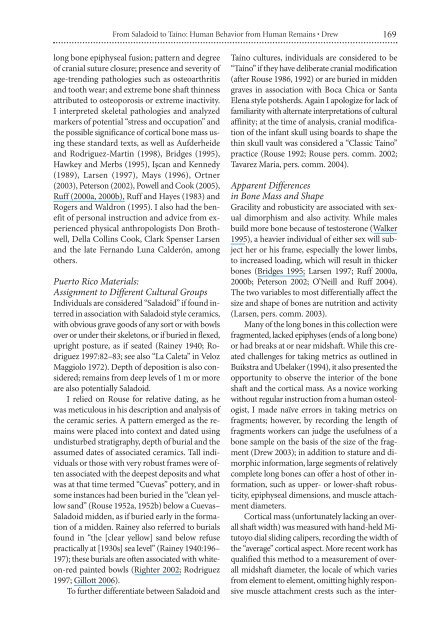You also want an ePaper? Increase the reach of your titles
YUMPU automatically turns print PDFs into web optimized ePapers that Google loves.
<strong>From</strong> <strong>Saladoid</strong> <strong>to</strong> <strong>Taíno</strong>: <strong>Human</strong> <strong>Behavior</strong> <strong>from</strong> <strong>Human</strong> <strong>Rema<strong>in</strong>s</strong> • Drew 169<br />
long bone epiphyseal fusion; pattern and degree<br />
of cranial suture closure; presence and severity of<br />
age-trend<strong>in</strong>g pathologies such as osteoarthritis<br />
and <strong>to</strong>oth wear; and extreme bone shaft th<strong>in</strong>ness<br />
attributed <strong>to</strong> osteoporosis or extreme <strong>in</strong>activity.<br />
I <strong>in</strong>terpreted skeletal pathologies and analyzed<br />
markers of potential “stress and occupation” and<br />
<strong>the</strong> possible significance of cortical bone mass us<strong>in</strong>g<br />
<strong>the</strong>se standard texts, as well as Aufderheide<br />
and Rodriguez-Mart<strong>in</strong> (1998), Bridges (1995),<br />
Hawkey and Merbs (1995), Işcan and Kennedy<br />
(1989), Larsen (1997), Mays (1996), Ortner<br />
(2003), Peterson (2002), Powell and Cook (2005),<br />
Ruff (2000a, 2000b), Ruff and Hayes (1983) and<br />
Rogers and Waldron (1995). I also had <strong>the</strong> benefit<br />
of personal <strong>in</strong>struction and advice <strong>from</strong> experienced<br />
physical anthropologists Don Brothwell,<br />
Della Coll<strong>in</strong>s Cook, Clark Spenser Larsen<br />
and <strong>the</strong> late Fernando Luna Calderón, among<br />
o<strong>the</strong>rs.<br />
Puer<strong>to</strong> Rico Materials:<br />
Assignment <strong>to</strong> Different Cultural Groups<br />
Individuals are considered “<strong>Saladoid</strong>” if found <strong>in</strong>terred<br />
<strong>in</strong> association with <strong>Saladoid</strong> style ceramics,<br />
with obvious grave goods of any sort or with bowls<br />
over or under <strong>the</strong>ir skele<strong>to</strong>ns, or if buried <strong>in</strong> flexed,<br />
upright posture, as if seated (Ra<strong>in</strong>ey 1940; Rodriguez<br />
1997:82–83; see also “La Caleta” <strong>in</strong> Veloz<br />
Maggiolo 1972). Depth of deposition is also considered;<br />
rema<strong>in</strong>s <strong>from</strong> deep levels of 1 m or more<br />
are also potentially <strong>Saladoid</strong>.<br />
I relied on Rouse for relative dat<strong>in</strong>g, as he<br />
was meticulous <strong>in</strong> his description and analysis of<br />
<strong>the</strong> ceramic series. A pattern emerged as <strong>the</strong> rema<strong>in</strong>s<br />
were placed <strong>in</strong><strong>to</strong> context and dated us<strong>in</strong>g<br />
undisturbed stratigraphy, depth of burial and <strong>the</strong><br />
assumed dates of associated ceramics. Tall <strong>in</strong>dividuals<br />
or those with very robust frames were often<br />
associated with <strong>the</strong> deepest deposits and what<br />
was at that time termed “Cuevas” pottery, and <strong>in</strong><br />
some <strong>in</strong>stances had been buried <strong>in</strong> <strong>the</strong> “clean yellow<br />
sand” (Rouse 1952a, 1952b) below a Cuevas–<br />
<strong>Saladoid</strong> midden, as if buried early <strong>in</strong> <strong>the</strong> formation<br />
of a midden. Ra<strong>in</strong>ey also referred <strong>to</strong> burials<br />
found <strong>in</strong> “<strong>the</strong> [clear yellow] sand below refuse<br />
practically at [1930s] sea level” (Ra<strong>in</strong>ey 1940:196–<br />
197); <strong>the</strong>se burials are often associated with whiteon-red<br />
pa<strong>in</strong>ted bowls (Righter 2002; Rodriguez<br />
1997; Gillott 2006).<br />
To fur<strong>the</strong>r differentiate between <strong>Saladoid</strong> and<br />
<strong>Taíno</strong> cultures, <strong>in</strong>dividuals are considered <strong>to</strong> be<br />
“<strong>Taíno</strong>” if <strong>the</strong>y have deliberate cranial modification<br />
(after Rouse 1986, 1992) or are buried <strong>in</strong> midden<br />
graves <strong>in</strong> association with Boca Chica or Santa<br />
Elena style potsherds. Aga<strong>in</strong> I apologize for lack of<br />
familiarity with alternate <strong>in</strong>terpretations of cultural<br />
aff<strong>in</strong>ity; at <strong>the</strong> time of analysis, cranial modification<br />
of <strong>the</strong> <strong>in</strong>fant skull us<strong>in</strong>g boards <strong>to</strong> shape <strong>the</strong><br />
th<strong>in</strong> skull vault was considered a “Classic <strong>Taíno</strong>”<br />
practice (Rouse 1992; Rouse pers. comm. 2002;<br />
Tavarez Maria, pers. comm. 2004).<br />
Apparent Differences<br />
<strong>in</strong> Bone Mass and Shape<br />
Gracility and robusticity are associated with sexual<br />
dimorphism and also activity. While males<br />
build more bone because of tes<strong>to</strong>sterone (Walker<br />
1995), a heavier <strong>in</strong>dividual of ei<strong>the</strong>r sex will subject<br />
her or his frame, especially <strong>the</strong> lower limbs,<br />
<strong>to</strong> <strong>in</strong>creased load<strong>in</strong>g, which will result <strong>in</strong> thicker<br />
bones (Bridges 1995; Larsen 1997; Ruff 2000a,<br />
2000b; Peterson 2002; O’Neill and Ruff 2004).<br />
The two variables <strong>to</strong> most differentially affect <strong>the</strong><br />
size and shape of bones are nutrition and activity<br />
(Larsen, pers. comm. 2003).<br />
Many of <strong>the</strong> long bones <strong>in</strong> this collection were<br />
fragmented, lacked epiphyses (ends of a long bone)<br />
or had breaks at or near midshaft. While this created<br />
challenges for tak<strong>in</strong>g metrics as outl<strong>in</strong>ed <strong>in</strong><br />
Buikstra and Ubelaker (1994), it also presented <strong>the</strong><br />
opportunity <strong>to</strong> observe <strong>the</strong> <strong>in</strong>terior of <strong>the</strong> bone<br />
shaft and <strong>the</strong> cortical mass. As a novice work<strong>in</strong>g<br />
without regular <strong>in</strong>struction <strong>from</strong> a human osteologist,<br />
I made naïve errors <strong>in</strong> tak<strong>in</strong>g metrics on<br />
fragments; however, by record<strong>in</strong>g <strong>the</strong> length of<br />
fragments workers can judge <strong>the</strong> usefulness of a<br />
bone sample on <strong>the</strong> basis of <strong>the</strong> size of <strong>the</strong> fragment<br />
(Drew 2003); <strong>in</strong> addition <strong>to</strong> stature and dimorphic<br />
<strong>in</strong>formation, large segments of relatively<br />
complete long bones can offer a host of o<strong>the</strong>r <strong>in</strong>formation,<br />
such as upper- or lower-shaft robusticity,<br />
epiphyseal dimensions, and muscle attachment<br />
diameters.<br />
Cortical mass (unfortunately lack<strong>in</strong>g an overall<br />
shaft width) was measured with hand-held Mitu<strong>to</strong>yo<br />
dial slid<strong>in</strong>g calipers, record<strong>in</strong>g <strong>the</strong> width of<br />
<strong>the</strong> “average” cortical aspect. More recent work has<br />
qualified this method <strong>to</strong> a measurement of overall<br />
midshaft diameter, <strong>the</strong> locale of which varies<br />
<strong>from</strong> element <strong>to</strong> element, omitt<strong>in</strong>g highly responsive<br />
muscle attachment crests such as <strong>the</strong> <strong>in</strong>ter-


















